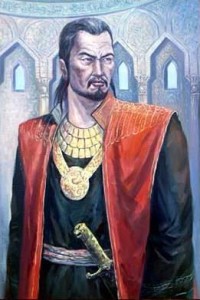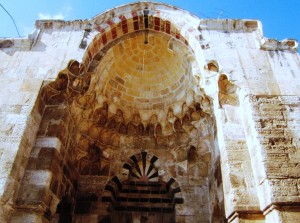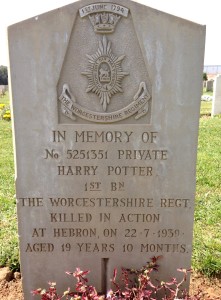On a recent warm, sunny morning I found myself in the beautifully manicured British war cemetery in Ramle. I was there looking for the grave of a young British lieutenant who died in 1920. He was a graduate of my husband’s high school in London, England. As he was attached to an obscure Indian regiment, the people documenting all the school’s fallen soldiers originally assumed Ramle was in one of the far flung corners of the British Raj. Rather belatedly, they discovered it was in fact located in Israel!
Most tourists have also never heard of Ramle and when people ask me about it I am hard pushed to find something complimentary to say about its current state. Located not far from Ben Gurion airport, it is a mixed Arab-Jewish city widely associated with crime and drugs. Whilst that is the unfortunate reality today, a number of municipal projects have been initiated to rehabilitate Ramle (and its neighbouring city of Lod) and bring it out of the mire and back to its former glory.
Despite present appearances, Ramle was established as the country’s capital city and served as such under various Moslem dynasties, the last of which was the rule of the Mamelukes. Notwithstanding the fact that they defeated the Crusaders and remained in power for over 250 years, most people have never heard of the Mamelukes either. So let me take this opportunity to give them and Ramle some coverage.
The term “Mameluke” means “owned” in Arabic, it was coined by the Seljuk Turks (Sunni Moslems) who would capture small boys as young as six or seven years old and sell them in slave markets. These children would be educated and incorporated into the various Moslem empires where they were taught to be administrators or trained as soldiers. The centre of Mameluke education was in Cairo. Quite possibly because of their early indoctrination, these slaves were very loyal to their rulers. At the age of 35-40 they would be released from servitude by the caliph. They could marry freely with the local women and their children were not considered slaves if the father had already been freed.
In 1258, the various Moslem dynasties in Baghdad, Cairo and Damascus were overthrown by a new force: the Monguls. These fearless fighters came from Mongolia, led by their ruthless leader Genghis Khan. Within two years they had advanced as far as the Land of Israel where they were challenged by an army far superior than any they had previously encountered. At the battle of Ein Jalut (Jalut means “Goliath”) believed to have taken place in the area of the Ein Harod valley, between Afula and Bet She’an, the Mongul and Mameluke forces met.
 The Monguls were severely hindered by their lack of familiarity with local conditions and for the first time they faced an opponent who out-smarted them. The Mongul horses, used to the grassy terrain of the Mongolian Steppes, did not have horseshoes unlike the Mameluke horses whose hooves were protected. Now they found themselves fighting on stony, basalt terraces which were very hard on the horses hooves. Mongul horses were accustomed to a diet of grass, whereas the Mamelukes fed their animals hay and made sure they had burnt all of the grazing area. The defeat of the tribal Mongul army was absolute, as the more professional Mameluke army routed the invaders.
The Monguls were severely hindered by their lack of familiarity with local conditions and for the first time they faced an opponent who out-smarted them. The Mongul horses, used to the grassy terrain of the Mongolian Steppes, did not have horseshoes unlike the Mameluke horses whose hooves were protected. Now they found themselves fighting on stony, basalt terraces which were very hard on the horses hooves. Mongul horses were accustomed to a diet of grass, whereas the Mamelukes fed their animals hay and made sure they had burnt all of the grazing area. The defeat of the tribal Mongul army was absolute, as the more professional Mameluke army routed the invaders.
The Moslem sultan stubbornly refused to award them for this triumph, so Baybars, his chief of staff, murdered him and appointed himself ruler instead. According to Mameluke protocol the strongest leader ruled. In this instance he was unusually tall and had one blue eye and one brown eye. He had been bought as a young boy by the emir of Damascus, but because of his strange appearance was sold on to the ruler in Cairo where he became his bodyguard and commander of the armed forces. Baybars’ demise is described in Simon Sebag Montefiore’s “Jerusalem the Biography” where the author relates how he prepared a poisoned drink for a guest “but then forgetfully drank it himself”. Mameluke rule in the Holy Land began in 1260 and ended in 1517 when they were defeated by the Ottoman Turks. However, to start with, they needed to vanquish the resident Crusaders.
Strangely enough, the majority of archaeological remains from this period can be found in Jerusalem, even though it was neither a civil nor administrative centre. The city was a desolate backwater and for the only time in its history didn’t even have a city wall. For the most part, the Mamelukes employed a scorched earth policy thoroughly destroying all the cities they conquered from the Crusaders, who, up until their arrival had been ruling the Holy Land. Because Jerusalem was not on a main road or accessible by sea, it may have been spared as it was not worth their bother. They perceived Crusader strength as coming from the sea, so the Mamelukes destroyed every city they conquered along the coast so as not to let them back in.
Ramle, was founded in 716 by the Ummayad dynasty as their capital (the same rulers who built the Dome of the Rock and Al Aksa mosque in Jerusalem) and is the only city in Israel that was founded as a Moslem Arab city. It assumed such importance that it was identified as the traditional burial place of the Prophet Mohammed’s family and friends, mentioned in the Koran. The name Ramle comes from the Arabic ‘raml’, meaning ‘sand’, referring to the sandy dunes on which the city was built. Its strategic location near the main road linking Syria in the north and Egypt in the south, that intersected with the road linking Jerusalem to the coast, ensured Ramle’s importance both economically and politically for a period of approximately 400 years.
The remains of Arab Ramle are buried under today’s modern city which means there are not many visible signs from this period. Two sites, however are worthy of mention. The first is the White Mosque, originally built in the 8th century and later repaired by the Mamelukes in the 14th century after its destruction in an earthquake. Its most striking feature is the minaret on the northern side of the mosque known as the White Tower. It was used both as a watch-tower and the place from which the muezzin would call the faithful to prayer. You can climb the tower and stand on its observation deck to enjoy an excellent panoramic view over Ramle and the surrounding area.
Underneath the mosque is a huge subterranean pool known as the Pool of Arches. The 400 square metre pool was originally built as a reservoir which was filled with water from natural rainfall or from a nearby aqueduct. There are openings in the ceiling through which water was drawn in ceramic vessels. The Arabic name for the pool is Birket El-Anzia, ‘the Goat Pool’, which suggests that in days gone by herds of goats were brought there to drink the water. These pools were probably also used by the local cloth dyers whose industrial premises were situated close by. Visitors can rent a rowing boat in order to explore the cistern and see the impressive huge stone arches and pillars that date back over 1200 years.
 Ramle also has a museum which displays artifacts from the city’s glory days. One of the exhibits attests to Ramle’s previous importance, as it was one of the few cities in the land where coins were minted. In the 1960’s a hoard of over 400 coins was discovered in the garden of a local resident whilst he was renovating his home. Some of these coins had been cut into smaller pieces signifying a time when small change did not yet exist and payment was made by weight.
Ramle also has a museum which displays artifacts from the city’s glory days. One of the exhibits attests to Ramle’s previous importance, as it was one of the few cities in the land where coins were minted. In the 1960’s a hoard of over 400 coins was discovered in the garden of a local resident whilst he was renovating his home. Some of these coins had been cut into smaller pieces signifying a time when small change did not yet exist and payment was made by weight.
Quite ironically, the British war cemetery, which is the largest one in Israel, has also become a tourist site for modern visitors. On the day I went looking for the grave of Lieutenant Caldwell, there was a group of 40 or so local Israeli’s looking for the grave of another British soldier. A certain Private, who was only nineteen years old when he was killed in Hebron, presumably in the riots of 1939, has become the cemetery’s most celebrated occupant. The reason, his name: Harry Potter.

